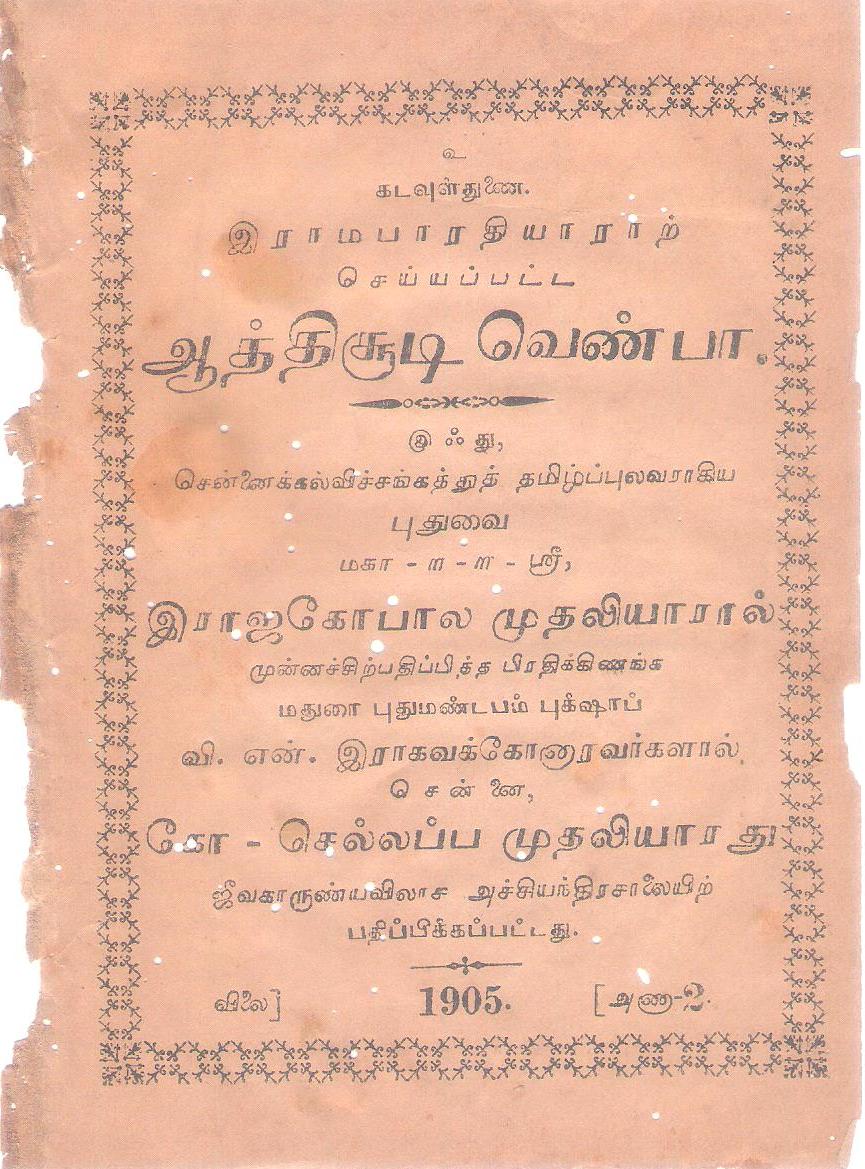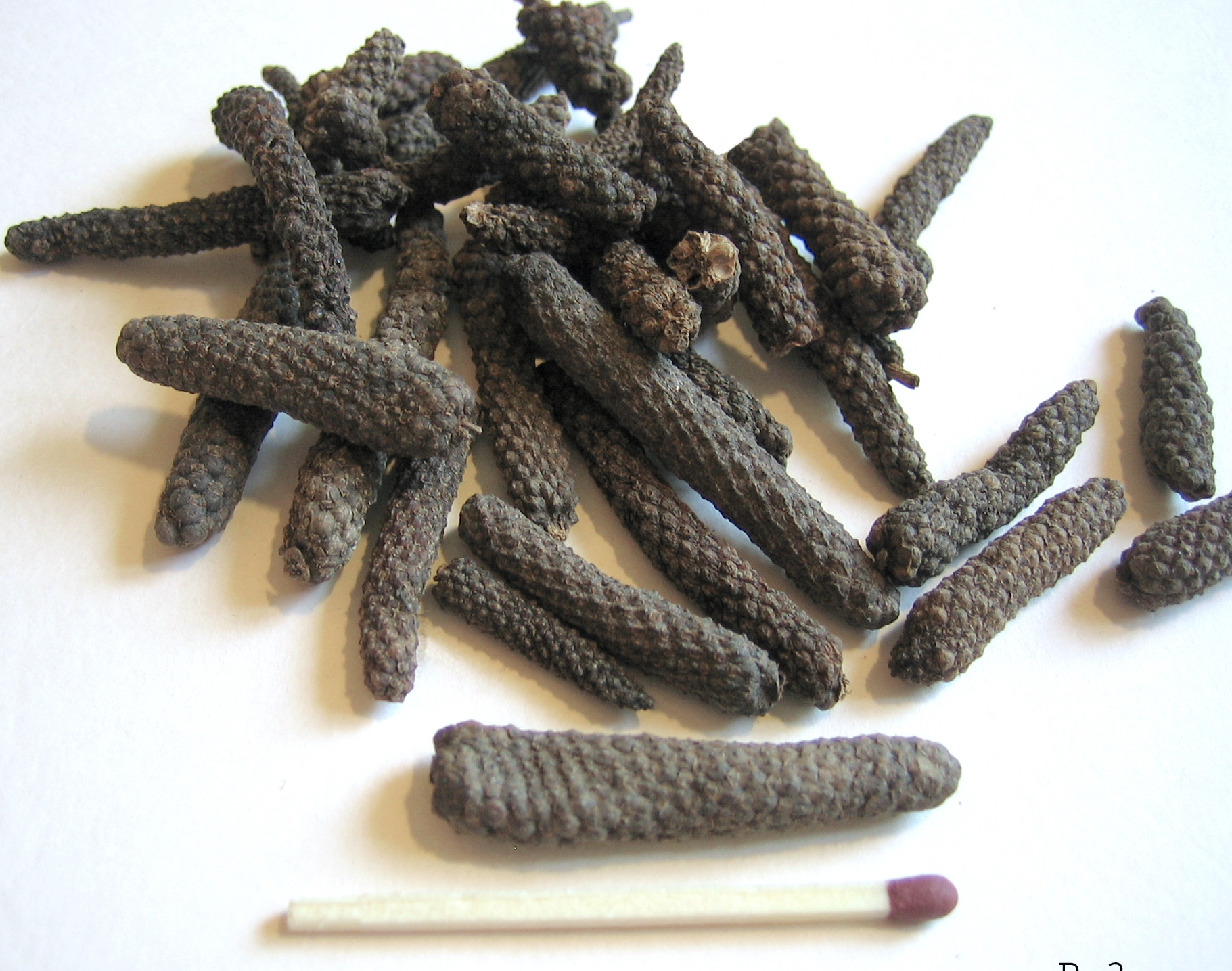|
Tirikaṭukam
Thirikatukam (Tamil: திரிகடுகம்) is a Tamil poetic work of didactic nature belonging to the Eighteen Lesser Texts (''Pathinenkilkanakku'') anthology of Tamil literature. This belongs to the 'post Sangam period' corresponding to between 100 and 500 CE. ''Thirikatukam'' contains 100 poems written by the poet Nallathanaar. The poems of ''Thirikatukam'' are written in the Venpa meter. ''Thirikatukam'' uses the analogy of the traditional herbal medicine, which uses the three herbs ''sukku'' (dried ginger), ''milaku'' ( pepper) and ''thippili'' (Long pepper Long pepper (''Piper longum''), sometimes called Indian long pepper or ''thippali'', is a flowering vine in the family Piperaceae, cultivated for its fruit, which is usually dried and used as a spice and seasoning. Long pepper has a taste simi ...) to cure maladies of the stomach. ''Thirikatugam'' similarly uses three different maxims to illustrate correct behaviour. References * Mudaliyar, Singaravelu ... [...More Info...] [...Related Items...] OR: [Wikipedia] [Google] [Baidu] |
Eighteen Lesser Texts
The Eighteen Lesser Texts, known as the Patiṉeṇkīḻkaṇakku ( ta, பதினெண்கீழ்கணக்கு) in the literature, is a collection of eighteen poetic works mostly created during the 'post Sangam period' (between 100 and 500 CE). The poems of this collection differ from the earlier works of the Eighteen Greater Texts (''Patiṉeṇmēlkaṇakku''), which are the oldest surviving Tamil poetry, in that the poems are written in the venpa meter and are relatively short in length. Naladiyar, having sung by 400 poets, is the only anthology in this collection. Each of the remaining works of the Eighteen Lesser Texts is sung by a single poet. Unlike the works of the Eighteen Greater Texts, most of the books of the Eighteen Lesser Texts deal with morals and ethics. Works of the "Eighteen lesser books" collection The Eighteen Lesser Texts contains the following books: * ''Nālaṭiyār'' * '' Nāṉmaṇikkaṭikai'' * '' Iṉṉā Nāṟpatu'' * '' Iṉiya ... [...More Info...] [...Related Items...] OR: [Wikipedia] [Google] [Baidu] |
Tamil Language
Tamil (; ' , ) is a Dravidian language natively spoken by the Tamil people of South Asia. Tamil is an official language of the Indian state of Tamil Nadu, the sovereign nations of Sri Lanka and Singapore, and the Indian territory of Puducherry. Tamil is also spoken by significant minorities in the four other South Indian states of Kerala, Karnataka, Andhra Pradesh and Telangana, and the Union Territory of the Andaman and Nicobar Islands. It is also spoken by the Tamil diaspora found in many countries, including Malaysia, Myanmar, South Africa, United Kingdom, United States, Canada, Australia and Mauritius. Tamil is also natively spoken by Sri Lankan Moors. One of 22 scheduled languages in the Constitution of India, Tamil was the first to be classified as a classical language of India. Tamil is one of the longest-surviving classical languages of India.. "Tamil is one of the two longest-surviving classical languages in India" (p. 7). A. K. Ramanujan described it as "the o ... [...More Info...] [...Related Items...] OR: [Wikipedia] [Google] [Baidu] |
Didactic
Didacticism is a philosophy that emphasizes instructional and informative qualities in literature, art, and design. In art, design, architecture, and landscape, didacticism is an emerging conceptual approach that is driven by the urgent need to explain. When applied to ecological questions, didacticism in art, design, architecture and landscape attempts to persuade the viewer of environmental priorities; thus, constituting an entirely new form of explanatory discourse that presents, what can be called "eco-lessons". This concept can be defined as "ecological didacticism". Overview The term has its origin in the Ancient Greek word διδακτικός (''didaktikos''), "pertaining to instruction", and signified learning in a fascinating and intriguing manner. Didactic art was meant both to entertain and to instruct. Didactic plays, for instance, were intended to convey a moral theme or other rich truth to the audience. During the Middle Age, the Roman Catholic chants like the ... [...More Info...] [...Related Items...] OR: [Wikipedia] [Google] [Baidu] |
Tamil Literature
Tamil literature has a rich and long literary tradition spanning more than two thousand years. The oldest extant works show signs of maturity indicating an even longer period of evolution. Contributors to the Tamil literature are mainly from Tamil people from South India, including the land now comprising Tamil Nadu, Kerala, Eelam Tamils from Sri Lanka, as well as the Tamil diaspora. The history of Tamil literature follows the history of Tamil Nadu, closely following the social, economical, political and cultural trends of various periods. The early Sangam literature, dated before 300 BCE, contain anthologies of various poets dealing with many aspects of life, including love, war, social values and religion.Akananuru (1, 15, 31, 55, 61, 65, 91, 97, 101, 115, 127, 187, 197, 201, 211, 233, 251, 265, 281, 311, 325, 331, 347, 349, 359, 393, 281, 295), Kurunthogai (11), and Natrinai (14, 75) are dated before 300 BCE. This was followed by the early epics and moral literature, autho ... [...More Info...] [...Related Items...] OR: [Wikipedia] [Google] [Baidu] |
Sangam Period
The Sangam period or age (, ), particularly referring to the third Sangam period, is the period of the history of ancient Tamil Nadu, Kerala and parts of Sri Lanka (then known as Tamilakam) spanning from c. 6th century BCE to c. 3rd century CE. It was named after the famous Sangam academies of poets and scholars centered in the city of Madurai. The First Sangam to be located in ''Then Madurai'' under the patronage of 89 Pandya kings, during this period. It is said to have lasted for 4,440 years, and this would put the First Sangam between 9600 BCE to 5200 BCE. In Old Tamil language, the term Tamilakam (''Tamiḻakam'', ''Purananuru'' 168. 18) referred to the whole of the ancient Tamil-speaking area, corresponding roughly to the area known as southern India today, consisting of the territories of the present-day Indian states of Tamil Nadu, Kerala, parts of Andhra Pradesh, parts of Karnataka and northern Sri Lanka also known as Eelam. History According to Tamil legends, t ... [...More Info...] [...Related Items...] OR: [Wikipedia] [Google] [Baidu] |
Venpa
Venpa or Venba ('' வெண்பா'' in Tamil) is a form of classical Tamil poetry. Classical Tamil poetry has been classified based upon the rules of metric prosody. Such rules form a context-free grammar. Every venba consists of between two and twelve lines. The venpa meter is used in songs of the types neṭu veṇ pāṭṭu ('long song in venpa meter'), kuṟu veṇ pāṭṭu 'short song in venpa meter', kaikkiḷai "one-sided love," and paripāṭṭu 'song that is quite accommodative' and in satirical compositions (aṅkatac ceyyuḷ). Popular books written in venba style # All 1330 couplets from the Thirukkural, composed by Thiruvalluvar, are examples of venba. Tirukkural comes under a sub-category of venba called Kural venba, wherein each kural or couplet has only two lines. # Nala venba 1 is another classical work written in venba style. # Niti venba 2 is another venba style book that preaches values. # Acharakkovai 3 is another venba style book that preaches v ... [...More Info...] [...Related Items...] OR: [Wikipedia] [Google] [Baidu] |
Ginger
Ginger (''Zingiber officinale'') is a flowering plant whose rhizome, ginger root or ginger, is widely used as a spice and a folk medicine. It is a herbaceous perennial which grows annual pseudostems (false stems made of the rolled bases of leaves) about one meter tall bearing narrow leaf blades. The inflorescences bear flowers having pale yellow petals with purple edges, and arise directly from the rhizome on separate shoots. Ginger is in the family Zingiberaceae, which also includes turmeric (''Curcuma longa''), cardamom (''Elettaria cardamomum''), and galangal. Ginger originated in Maritime Southeast Asia and was likely domesticated first by the Austronesian peoples. It was transported with them throughout the Indo-Pacific during the Austronesian expansion ( BP), reaching as far as Hawaii. Ginger is one of the first spices to have been exported from Asia, arriving in Europe with the spice trade, and was used by ancient Greeks and Romans. The distantly related dicot ... [...More Info...] [...Related Items...] OR: [Wikipedia] [Google] [Baidu] |
Black Pepper
Black pepper (''Piper nigrum'') is a flowering vine in the family Piperaceae, cultivated for its fruit, known as a peppercorn, which is usually dried and used as a spice and seasoning. The fruit is a drupe (stonefruit) which is about in diameter (fresh and fully mature), dark red, and contains a stone which encloses a single pepper seed. Peppercorns and the ground pepper derived from them may be described simply as ''pepper'', or more precisely as ''black pepper'' (cooked and dried unripe fruit), ''green pepper'' (dried unripe fruit), or ''white pepper'' (ripe fruit seeds). Black pepper is native to the Malabar Coast of India, and the Malabar pepper is extensively cultivated there and in other tropical regions. Ground, dried, and cooked peppercorns have been used since antiquity, both for flavour and as a traditional medicine. Black pepper is the world's most traded spice, and is one of the most common spices added to cuisines around the world. Its spiciness is due to the ch ... [...More Info...] [...Related Items...] OR: [Wikipedia] [Google] [Baidu] |
Long Pepper
Long pepper (''Piper longum''), sometimes called Indian long pepper or ''thippali'', is a flowering vine in the family Piperaceae, cultivated for its fruit, which is usually dried and used as a spice and seasoning. Long pepper has a taste similar to, but hotter than, that of its close relative ''Piper nigrum'' – from which black, green and white pepper are obtained. The fruit of the pepper consists of many minuscule fruits – each about the size of a poppy seed – embedded in the surface of a flower spike that closely resembles a hazel tree catkin. Like ''Piper nigrum'', the fruits contain the alkaloid piperine, which contributes to their pungency. Another species of long pepper, '' Piper retrofractum'', is native to Java, Indonesia. The fruits of this plant are often confused with chili peppers, which belong to the genus ''Capsicum'', originally from the Americas. History The oldest known reference to long pepper comes from ancient Indian textbooks of Ayurveda, where its ... [...More Info...] [...Related Items...] OR: [Wikipedia] [Google] [Baidu] |
Maxim (saying)
Maxim or Maksim may refer to: Entertainment * ''Maxim'' (magazine), an international men's magazine ** ''Maxim'' (Australia), the Australian edition ** ''Maxim'' (India), the Indian edition * Maxim Radio, ''Maxim'' magazine's radio channel on Sirius Satellite Radio *''Maxim'', a fictional ship in the manga and anime series ''One Piece'' *Maxim, the hero of the video game '' Lufia II: Rise of the Sinistrals'' and its remake, '' Lufia: Curse of the Sinistrals'' Literature and language *A species of adage, aphorism, or saying that expresses a general moral rule, especially a philosophical maxim * ''Maxims'' (Old English poems), examples of gnomic poetry *'' Maximes'' (1665–78) of François de La Rochefoucauld (1613–80) Organizations * Mary Maxim, craft and needlework mail-order company in Canada * Maxim Brewery, brewing company in England * Maxim's Catering, chain of caterers, restaurants, and fast food shops in Hong Kong * Maxim Healthcare Services, medical staffing and h ... [...More Info...] [...Related Items...] OR: [Wikipedia] [Google] [Baidu] |
Project Madurai
Project Madurai (மதுரை தமிழ் இலக்கிய மின்தொகுப்புத் திட்டம்) is an open and voluntary initiative to publish free versions of ancient Tamil literature on the Internet. Texts are published in both TSCII (Tamil Script Code for Information Interchange), since its launch in 1998 and Unicode formats from 2004. The project was led by Dr. K. Kalyanasundaram, Lausanne, Switzerland (Project Leader) and Dr. P. Kumar Mallikarjunan, Blacksburg, Va, USA (Dy. Project Leader). Project Madurai is one among many projects those are currently active worldwide which attempt to put ancient literary works in electronic form. The etexts are distributed in both HTML and PDF file formats History The Madurai project was initially made with the Inaimadhi and Mayilai Tamil fonts. But since 1999, mobile phones have been produced and produced by the Tamil-language Tamil database ( Tamil Script Code for Information Interchange - T ... [...More Info...] [...Related Items...] OR: [Wikipedia] [Google] [Baidu] |






